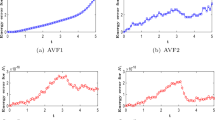Abstract
Some embedded Runge-Kutta methods for the numerical solution of the eigenvalue Schrödinger equation are developed. More specifically, a new embedded modified Runge-Kutta 4(6) Fehlberg method with minimal phase-lag and a block embedded Runge-Kutta-Fenlberg method are developed. For the numerical solution of the eigenvalue Schrödinger equation we investigate two cases. (i) The specific case, in which the potential V x is an even function with respect to x. It is assumed, also, that the wavefunctions tend to zero for x → ± ∞. (ii) The general case for the well-known cases of the Morse potential and Woods-Saxon or Optical potential. Numerical and theoretical results show that the new approaches are more efficient compared with the well-known Runge-Kutta-Fehlberg 4(5) method.
Similar content being viewed by others
References
Gh. Adam, L.Gr. Ixaru and A. Corciovei, A first-order perturbative numerical method for the solution of the radial Schrödinger equation, J. Comput. Phys. 22 (1976) 1–33.
N. Bessis and G. Bessis, A note on the Schrödinger equation for the x 2 + λx 2 /(1 + gx 2) potential, J. Math. Phys. 21 (1980) 2780–2785.
L. Brusa and L. Nigro, A one-step method for direct integration of structural dynamical equations, Internat. J. Numer. Methods Engrg. 15 (1980) 685–699.
J.R. Cash, A.D. Raptis and T.E. Simos, A sixth-order exponentially fitted method for the numerical solution of the radial Schrödinger equation, J. Comput. Phys. 91 (1990) 413–423.
V. Fack, H. De Meyer and G. Vanden Berghe, Dynamic-group approach to the x 2 + öx 2 /(1 + gx 2), J. Math. Phys. 27 (1986) 1340–1343.
V. Fack, H. De Meyer and G. Vanden Berghe, Some finite difference methods for computing eigenvalues and eigenvectors of special two-point boundary value problems, J. Comput. Appl. Math. 20 (1987) 211–217.
V. Fack and G. Vanden Berghe, A finite difference approach for the calculation of perturbed oscillator energies, J. Phys. A: Math. Gen. 18 (1985) 3355–3363.
V. Fack and G. Vanden Berghe, A programme for the calculation of energy eigenvalues and eigenstates of a Schrödinger equation, Comput. Phys. Commun. 39 (1986) 187–196.
V. Fack and G. Vanden Berghe, (Extended) Numerov method for computing eigenvalues of specific Schrödinger equations, J. Phys. A: Math. Gen. 20 (1987) 4153–4160.
E. Fehlberg, Low-order classical Runge–Kutta formulas with stepsize control and their application to some heat transfer problems, NASA Technical Report 315, USA (1969).
G.P. Flessas, On the Schrödinger equation for the x 2 + λx 2 /(1 + gx 2) interaction, Phys. Lett. 83A (1981) 121–122.
G.P. Flessas, Definite integrals as solutions for the x 2 + λx 2 /(1 + gx 2) potential, J. Phys. A: Math. Gen. 15 (1982) L97–L101.
P.J. van der Houwen and B.P. Sommeijer, Explicit Runge–Kutta(–Nyström) methods with reduced phase errors for computing oscillating solutions, SIAM J. Numer. Anal. 24 (1987) 595–617.
R.S. Kaushal, Small g and large λ solution of the Schrödinger equation doe the interaction x 2 + λx 2 /(1 + gx 2), J. Phys. A: Math. Gen. 12 (1979) L253–L258.
J.P. Killingbeck, Some applications of perturbation theory to numerical integration methods for the Schrödinger equation, Comput. Phys. Commun. 18 (1979) 211–214.
H. Kobeissi and M. Kobeissi, On testing difference equations for the diatomic eigenvalue problem, J. Comput. Chem. 9 (1988) 844–850.
C.S. Lai and H. Lin, On the Schrödinger equation for the interaction x 2 + λx 2 /(1 + gx 2), J. Phys. A: Math. Gen. 15 (1982) 1495–1502.
L.D. Landau and F.M. Lifshitz, Quantum Mechanics (Pergamon Press, New York, 1965).
A. Mitra, On the interaction of the type x 2 + λx 2 /(1 + gx 2), J. Math. Phys. 19 (1978) 2018–2022.
T.E. Simos, Numerical solution of ordinary differential equations with periodical solution, Doctoral dissertation, National Technical University of Athens (1990).
T.E. Simos, Exponential fitted methods for the numerical integration of the Schrödinger equation, Comput. Phys. Commun. 71 (1992) 32–38.
T.E. Simos, Runge–Kutta interpolants with minimal phase-lag, Comput. Math. Appl. 26 (1993) 43–49.
T.E. Simos, Eighth order methods with minimal phase-lag for accurate computations for the elastic scattering phase-shift problem, J. Math. Chem. 21 (1997) 359–372.
T.E. Simos and A.B. Sideridis, Accurate numerical approximations to initial value problems with periodical solutions, Computing 50 (1993) 87–92.
V.S. Varma, On the x 2 + λx 2 /(1 + gx 2) interaction, J. Phys. A: Math. Gen. 14 (1981) L489–L492.
R.R. Whitehead, A. Watt, G.P. Flessas and M.A. Nagarajan, Exact solutions of the Schrödinger equation (−d2/dx 2 + x 2 + λx 2/(1 +"> gx 2))y(x) = Ey(x), J. Phys. A: Math. Gen. 15 (1982) 1217–1226.
T. Yano, K. Kitani, M. Otsuka, S. Tomiyoshi, S. Matsushima, T. Wada and Y. Ezawa, A high speed method for eigenvalue problems III. Case of unsymmetrical potentials in Milne's method, Comput. Phys. Commun. 81 (1994) 409–424.
Author information
Authors and Affiliations
Rights and permissions
About this article
Cite this article
Simos, T. Some embedded modified Runge-Kutta methods for the numerical solution of some specific Schrödinger equations. Journal of Mathematical Chemistry 24, 23–37 (1998). https://doi.org/10.1023/A:1019102131621
Issue Date:
DOI: https://doi.org/10.1023/A:1019102131621



